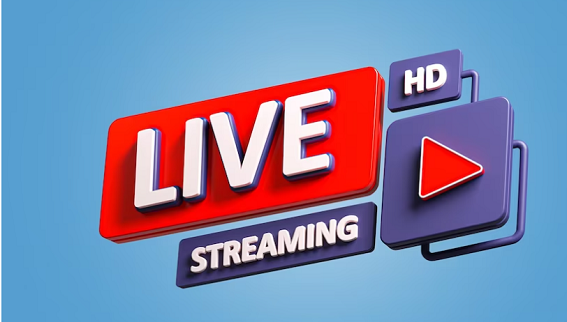Live Streaming: A Comprehensive Guide to Broadcasting in Real-Time

Live streaming has transformed how people consume content, from social media and events to educational content and entertainment. It allows users to broadcast real-time video to an online audience, enabling instant interaction and engagement. This article will cover the basics of live streaming, how it works, its benefits, and tips for getting started.
What is Live Streaming?
Live streaming is a technology that enables people to broadcast video content over the internet in real time. Whether it’s a live concert, a sports game, or a social media event, live streaming allows viewers to watch as events unfold without waiting for uploads or pre-recorded material. With advancements in technology, live streaming has become accessible to nearly everyone with an internet connection and a device with a camera.
How Does Live Streaming Work?
The process of live streaming involves capturing audio and video from a camera or smartphone and sending it to an online platform, such as YouTube, Facebook, or Twitch, where viewers can watch it in real time. Here’s a breakdown of how it works:
- Capturing Content: The camera records audio and visual content in real time.
- Encoding and Compression: The captured content is encoded and compressed to reduce file size, making it easier to stream over the internet.
- Streaming Platform: The video is sent to a streaming platform, which allows viewers to access and view the content instantly.
- Buffering and Playback: The platform buffers the content slightly before playing it to viewers, ensuring a smooth experience with minimal lag.
Benefits of Live Streaming
Live streaming offers numerous advantages for both individuals and businesses, providing a unique way to connect with audiences in real time.
1. Immediate Interaction with Viewers
Live streaming enables direct engagement between the broadcaster and the audience. Viewers can comment, ask questions, and give feedback instantly, which creates a more interactive experience compared to pre-recorded content.
2. Wider Reach
With live streaming, broadcasters can reach a global audience. People from around the world can tune in, making it an effective tool for events, brand promotions, and public announcements.
3. Cost-Effective Content Creation
Live streaming is a cost-effective method of broadcasting compared to traditional methods, which often require expensive equipment and studio setups. Many social media platforms offer free live streaming options, making it accessible for individuals and small businesses.
4. Increased Audience Engagement
Live streaming keeps audiences engaged because it creates a sense of immediacy. Viewers know that they’re watching events as they happen, which can make them feel more connected and involved.
5. Easy Accessibility
Most people have access to devices with cameras, such as smartphones and laptops, allowing nearly anyone to start live streaming. Many platforms also make it simple to stream live content, often with just a few clicks.
Popular Platforms for Live Streaming
There are several platforms that make live streaming easy and accessible. Here are some of the most widely used live streaming platforms:
1. YouTube Live
YouTube Live is popular for its extensive reach and easy-to-use interface. It’s ideal for a variety of content types, including educational videos, tutorials, and events.
2. Facebook Live
Facebook Live is widely used for personal streaming, business promotion, and community engagement. The platform allows real-time comments and reactions, creating an interactive experience.
3. Twitch
Twitch is primarily used by gamers, but it also supports a wide range of content, including music performances, talk shows, and more. Twitch has a dedicated audience interested in gaming and entertainment.
4. Instagram Live
Instagram Live is a great option for brands and influencers looking to reach followers on Instagram. The platform is user-friendly and allows viewers to engage with the streamer through comments.
5. LinkedIn Live
LinkedIn Live is designed for professional content, such as business webinars, conferences, and interviews. It helps professionals and companies connect with their target audience in real time.
Tips for Successful Live Streaming
If you’re considering starting live streaming, here are some tips to help ensure a successful broadcast:
1. Plan Your Content
Before going live, plan what you’re going to talk about or showcase. Having a clear structure and objective helps keep viewers engaged and ensures the broadcast runs smoothly.
2. Test Your Equipment
Testing your equipment, such as the camera, microphone, and internet connection, is crucial. Poor audio or video quality can deter viewers, so make sure everything is working properly.
3. Engage with Your Audience
Engagement is key to a successful live stream. Address viewer comments, answer questions, and make your audience feel involved. This interaction can boost viewer satisfaction and increase engagement.
4. Promote Your Live Stream
To attract more viewers, promote your live stream ahead of time. Share the details on your social media channels and encourage your audience to join you.
5. Analyze Your Performance
Most platforms provide insights into viewer behavior, such as watch time and audience demographics. Use this data to improve future live streams and better understand your audience.
Challenges in Live Streaming
While live streaming is an excellent tool for engagement, it does come with some challenges:
- Technical Difficulties: Issues such as lagging, buffering, or poor video quality can negatively impact the viewer experience.
- Time Constraints: Live streaming requires you to stick to a schedule, which can be challenging if you’re trying to reach a global audience in different time zones.
- Maintaining Audience Engagement: Keeping viewers engaged in a live broadcast can be challenging, especially if the content isn’t interactive or compelling.
The Future of Live Streaming
Live streaming is constantly evolving as new technologies emerge. Here are some trends to watch for in the live streaming industry:
- Virtual and Augmented Reality: Integrating VR and AR into live streaming is likely to create more immersive experiences for viewers.
- Improved Interactivity: As technology improves, live streaming will continue to offer more interactive features, such as live polls, instant purchasing options, and customizable views.
- Artificial Intelligence: AI may be used to improve video quality, automate content moderation, and personalize live streams based on viewer preferences.
Conclusion
Live streaming is a powerful tool for real-time communication, allowing individuals, brands, and organizations to engage with audiences in a unique and interactive way. From social media to professional webinars, live streaming provides a versatile platform for sharing information, entertainment, and insights with viewers worldwide. As technology continues to advance, live streaming will only become more accessible and impactful, offering even more opportunities for connection.
FAQs
1. What equipment is needed for live streaming?
To start live streaming, you need a camera, microphone, and a stable internet connection. Many people use smartphones, but professional setups may include high-definition cameras and external mics.
2. Which platform is best for live streaming?
The best platform depends on your target audience. YouTube Live, Facebook Live, and Instagram Live are popular for general content, while LinkedIn Live is ideal for professional events.
3. How can I improve audience engagement during a live stream?
Engage with your audience by addressing comments, answering questions, and involving them in the content. Interaction can help retain viewers and make the experience more enjoyable.
4. Is live streaming expensive?
Live streaming can be affordable, especially on social media platforms that don’t charge fees. However, investing in quality equipment may increase costs if you want professional-grade broadcasts.
5. What are the future trends in live streaming?
Emerging trends include the integration of VR and AR, enhanced interactivity, and AI-driven features that personalize content and improve video quality.



